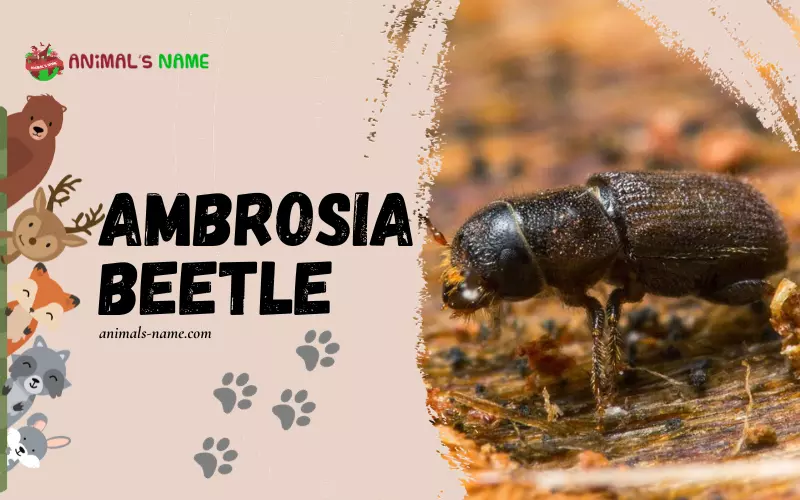The Ambrosia Beetle is a fascinating creature belonging to the animal kingdom. This tiny beetle has a rich history that dates back many years. This blog post will explore the intriguing facts about this unique insect species, including its size, habitat, and classification.
Firstly, let’s talk about the history of the Ambrosia Beetle. These beetles have been around long, with fossils dating back millions of years. They are named after Ambrosia, the food of the gods in Greek mythology because they have a close association with fungi that resembles this mythical food. This unique relationship between beetles and fungi has been going on for centuries.
Next, let’s delve into some interesting facts about the Ambrosia Beetle. They are tiny creatures, measuring about 2-4 millimetres in length, making them quite challenging to spot with the naked eye. Despite their size, they play a crucial role in ecosystems by aiding in the decomposition of dead trees and spreading fungal spores.
History of Ambrosia Beetle
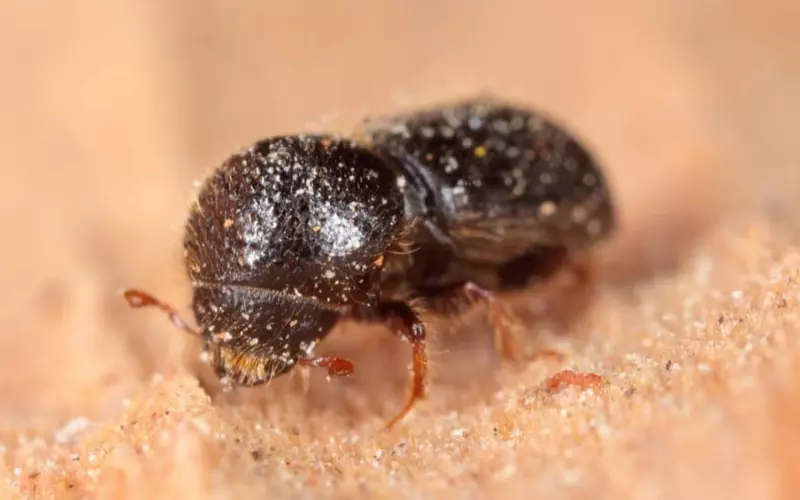
The ambrosia beetle is a tiny insect that belongs to the weevil family. It is known for its unique behaviour of farming fungus inside trees. These beetles have a long history that dates back millions of years. Fossil records show that they existed during the late Cretaceous period. The first fossil evidence of ambrosia beetles was found in Northern Europe and North America.
Ambrosia beetles are named after the ambrosia fungus that they cultivate. The female beetles burrow into trees and create tunnels in the wood. They then introduce the ambrosia fungus, their primary food source, into these tunnels. The fungus helps break down the wood, creating a suitable environment for the beetles to lay their eggs. As the larvae hatch, they feed on the fungus until they become adult beetles.
These beetles play an essential role in forest ecosystems. While they may harm individual trees, they contribute to the overall health of the forest. By creating tunnels in the wood, the beetles help aerate the trees and improve nutrient circulation. Additionally, when the beetles introduce the ambrosia fungus, it helps decompose dead wood, essential for recycling nutrients in the forest.
The ambrosia beetle is a fascinating creature with a long history. Its unique farming behaviour and cultivation of the ambrosia fungus benefit both the beetles and the forest ecosystem. Understanding the role of these beetles helps us appreciate the intricate web of interactions that keep our forests healthy.
Importance of Ambrosia Beetle
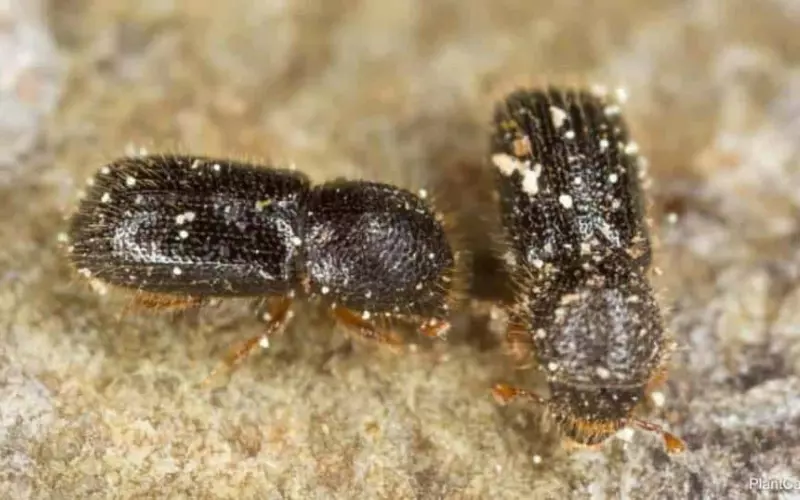
The Ambrosia Beetle is a small animal that plays a significant role in nature. These beetles are essential because they help decompose and recycle trees into the soil. When a tree dies, the Ambrosia Beetle’s job is to break it down into small pieces. They do this by tunnelling into the tree and laying their eggs inside. As the eggs hatch, the beetles eat the tree, turning it into tiny pieces.
This process is essential because it helps to keep the forest healthy. If there were no Ambrosia Beetles, dead trees would pile up and take a long time to decompose. This would create a big mess! With the help of these beetles, the dead trees are recycled and turned into nutrients for new plants to grow. This is a natural way of recycling that keeps the forest ecosystem in balance.
In addition to decomposing trees, the Ambrosia Beetle also helps to spread the fungus. When they lay their eggs inside the tree, they also introduce a type of fungus. This fungus grows inside the tree and feeds the beetles. But the fungus doesn’t harm the trees but helps them grow. This critical symbiotic relationship between the beetle and the fungus helps to maintain a healthy environment for all living things in the forest.
Amazing Facts About Ambrosia Beetle

1. Ambrosia beetles belong to a family of tiny insects called Curculionidae, which includes more than 3,500 known species.
2. These beetles are relatively small, measuring only 2 to 7 millimetres.
3. Ambrosia beetles are primarily black or brown, with cylindrical bodies and a hard exoskeleton.
4. Despite their name, ambrosia beetles are not beetles of the ambrosia flower. They are named after their close association with ambrosia fungi.
5. Unlike other beetles that feed on plants, ambrosia beetles have an enjoyable diet around ambrosia fungi.
6. The females of ambrosia beetles bore into the wood of a host tree, creating tunnels or galleries where they cultivate ambrosia fungi.
7. These fungi are the primary food source for the beetles and their larvae. The beetles depend on the fungi, not the wood itself.
8. Ambrosia beetles have a unique way of cultivating the fungi. They carry fungal spores in unique structures called myalgia, located on their bodies.
9. When the female beetle bores into the tree, she introduces the fungal spores. The spores germinate and grow in the tunnels, providing a constant food source for the beetles.
10. The larvae of ambrosia beetles feed on the cultivated fungal mats within the tunnels until adulthood.
11. Some ambrosia beetle species are considered pests because they attack and damage various tree species, including fruit trees, ornamental plants, and timber trees.
12. The entry holes of ambrosia beetles can weaken the host tree, making it more susceptible to other diseases and environmental stressors.
13. Ambrosia beetles are found worldwide, except in icy regions like the Arctic and Antarctic.
14. These beetles play an essential role in forest ecosystems by breaking down decomposing wood and aiding in nutrient recycling.
15. Ambrosia beetles have evolved a fascinating symbiotic relationship with ambrosia fungi, highlighting the intricate interdependence of different natural organisms.
Can we keep Ambrosia Beetle as our Pet?

Ambrosia beetles are fascinating creatures in nature, but they are not suitable or safe to be kept as pets. These beetles have their natural habitat and play essential roles in the ecosystem. It is always best to let them thrive in their natural environment rather than trying to keep them as pets at home.
Ambrosia beetles are not a common choice for pets because they have specific needs that cannot be easily met in a household setting. These beetles require specific types of wood to survive and have specific behaviours and habits that are difficult to replicate in a home environment. They also play crucial roles in maintaining the balance of the ecosystems they inhabit, helping to decompose wood and recycle nutrients.
Unfortunately, some species of ambrosia beetles have become extinct due to various factors such as habitat loss, climate change, and human activities. Their extinction is a significant loss for our planet as these beetles had unique characteristics and contributed to the biodiversity of our ecosystems. With their extinction, keeping them as pets is impossible, as they no longer exist in the wild or captivity.
Ambrosia beetles are not suitable or safe to be kept as pets. Their natural habitat is where they should be allowed to thrive and play essential roles in the ecosystem. Furthermore, if a species of ambrosia beetle becomes extinct, keeping them as pets is no longer possible. It is essential to respect and appreciate the natural world and its creatures, letting them live as they are meant to.
Size of Ambrosia Beetle
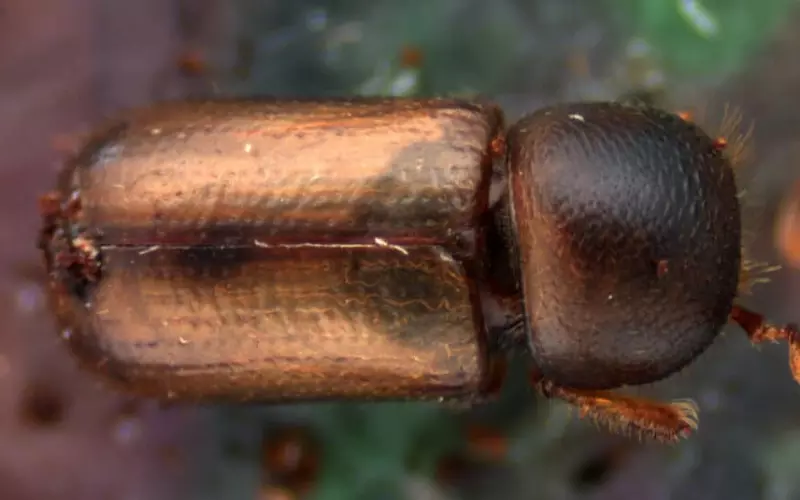
The Ambrosia Beetle is a tiny creature that measures about 1/10th of an inch in length. It may seem small, but it is loaded with unique features. Despite its size, the Ambrosia Beetle is a master of survival in various parts of the world. This remarkable animal may be small, but it surely knows how to make a significant impact.
Although seeing this creature with the naked eye is complex, the Ambrosia Beetle has incredible abilities. It has sharp jaws that allow it to burrow into trees, where it creates a cosy home. These beetles are clever architects, and they farm fungus within the trees. They drill holes and plant the fungus, which becomes their food. This symbiotic relationship benefits both the beetle and the fungus.
Unlike many large animals that may seem more powerful, the Ambrosia Beetle has its unique strengths. It thrives in its natural habitat, leaving a lasting impact on the trees it inhabits. It may be small, but its role in nature is significant. The next time you explore, watch for this small and mighty creature and remember that size doesn’t always determine importance.
Habitat of Ambrosia Beetle

The Ambrosia Beetle is a small animal found in many different habitats worldwide. These beetles are often found in forests, where they make their homes in the trunks of trees. They also like to live in gardens and parks, where they can find plenty of plants and trees to feed on.
One important thing to know about the habitat of the Ambrosia Beetle is that they like to live in dead or dying trees. These trees provide a perfect home for the beetles, as they can burrow into the wood and create tunnels to lay their eggs. The beetles also have a special relationship with a fungus that grows in the trees. The beetles feed on the fungus; in return, the fungus helps break down the wood, providing the beetles with a place to live.
Another essential part of the Ambrosia Beetle’s habitat is the plants and trees that it feeds on. These beetles are attracted to the sap of certain trees, such as oak and pine. They use their strong jaws to chew through the bark and access the sap, giving them the nutrients they need to survive. The beetles can also feed on ornamental plants and fruit trees in gardens and parks.
The Ambrosia Beetle can be found in various habitats, including forests, gardens, and parks. They prefer to live in dead or dying trees, where they can burrow into the wood and lay their eggs. They also feed on specific plants and trees’ sap, providing the necessary nutrients. It is essential to understand the habitat of the Ambrosia Beetle to protect and preserve these fascinating creatures.
Evolution of Ambrosia Beetle

The ambrosia beetle is a fascinating creature that has undergone many changes. Its evolution began millions of years ago when it was just a regular beetle with no unique traits. However, the beetle had to adapt to survive as the environment changed.
One of the significant changes in the evolution of the ambrosia beetle was the development of specialized mouthparts. These mouthparts allowed the beetle to bore into trees and create tunnels. This proved to be a beneficial adaptation because it provided the beetle with a protected habitat and food source, as it could feast on the tree’s nutrient-rich sap.
Another critical step in the beetle’s evolution was establishing a symbiotic relationship with a specific type of fungus. The beetle would carry the spores of this fungus with it as it moved from tree to tree. As the beetle bored into a new tree, it would introduce the fungus into the tunnels, where it would grow and provide food for the beetle. This mutualistic relationship greatly enhanced the beetle’s chances of survival.
Overall, the evolution of the ambrosia beetle is a remarkable story of adaptation and symbiosis. By developing specialized mouthparts and establishing a beneficial partnership with a fungus, the beetle was able to thrive in its changing environment. These adaptations have allowed the ambrosia beetle to become a successful species in many parts of the world.
Classification of Ambrosia Beetle

The ambrosia beetle is a tiny animal belonging to the Curculionidae insect family. These beetles are also known as wood-boring beetles because they have a unique ability to burrow into trees. They get their name from the ambrosia fungus they cultivate and eat in the tunnels they create.
There are over 3,000 different species of ambrosia beetles worldwide, and they can be found in almost every continent except Antarctica. Despite their small size, these beetles can cause big problems for trees. When a female ambrosia beetle finds a suitable tree, she will lay her eggs inside the bark. The larvae hatch and develop within the tree, feeding on the ambrosia fungus. Eventually, the adult beetles tunnel their way out, leaving behind a network of tunnels and weakened trees that can even lead to the tree’s death.
Each species of ambrosia beetle has its unique characteristics. They vary in size, colour, and behaviour. Some ambrosia beetles prefer certain trees, while others are more generalists. Some species are native to specific regions, while others have been introduced to new areas. These beetles have evolved to become masters of tree colonization, finding new homes in different types of wood.
Ambrosia beetles are diverse insects that can bore into trees and create tunnels. They are part of the Curculionidae family, also known as wood-boring beetles. With over 3,000 species, ambrosia beetles can be found worldwide and cause significant damage to trees. It is fascinating to learn about the unique characteristics and behaviours of these tiny but impactful creatures.
Different Types of Ambrosia Beetle

1. Asian Ambrosia Beetle: This small, black beetle is native to Southeast Asia and has spread to many parts of the world. It bores into trees, introducing a fungus that it cultivates for food. Their infestations can cause tree damage and death, affecting various plants and forests.
2. Granulate Ambrosia Beetle: These tiny beetles are known for their coarse appearance and reddish-brown colour. They infest various trees, including ornamental and fruit trees, damaging their woody tissues. The female beetles cultivate a fungus they use as a food source, leading to tree decline and potential death.
3. Mediterranean Ambrosia Beetle: Originating from the Mediterranean region, these beetles have spread globally. They bore into various trees, including citrus, ornamental, and tree fruits. The beetles introduce a fungus that infects the trees, causing branch dieback and potential tree decline.
4. Tea Shot Hole Borer: Found in Asia and parts of Africa, this beetle attacks various tree species, including many fruit trees. It carries a fungus that causes Fusarium dieback, which can lead to tree death. Infestations can be detrimental to agricultural and natural ecosystems.
5. Redbay Ambrosia Beetle: These beetles are native to Southeast Asia and have become an invasive species in the United States. They attack trees in the laurel family, such as redbay, sassafras, and avocado trees. Ambrosia beetles introduce a fungus that spreads throughout the tree, eventually leading to tree death.
6. Polyphagous Shot Hole Borer: Originally from Southeast Asia, this beetle has spread to California and other parts of the world. It bores into many trees, including maple, willow, and sycamore. The beetle carries a fungus that causes a disease called Fusarium dieback and can lead to tree mortality.
7. Black Stem Borer: Native to North America, this beetle attacks various deciduous trees, including oak, hickory, and maple. The larvae bore into tree stems, causing damage and weakening of the tree. Infestations can lead to tree decline and provide entry points for other pests and diseases.
8. Xyleborus Beetle: These tiny beetles are found in tropical and subtropical regions worldwide, attacking a variety of trees. They create galleries and introduce a fungal spore mass into the wood, which nourishes the beetle and its larvae. Prolonged infestations can lead to tree decline and even death in some cases.
9. Black Twig Borer: Originating from Southeast Asia, this beetle has become a pest in many parts of the world. It tunnels into the twigs and branches of various fruit trees, such as avocado, mango, and citrus. The damage caused by the beetle can result in reduced yields and overall tree health decline.
10. Walnut Twig Beetle: These beetles are native to western North America and target walnut trees. They create tunnels in the twigs and branches of the trees, introducing a fungus that causes a thousand canker diseases. Infestations can kill the tree, impacting the industry’s production and walnut tree populations.
Geographical Presence of Ambrosia Beetle
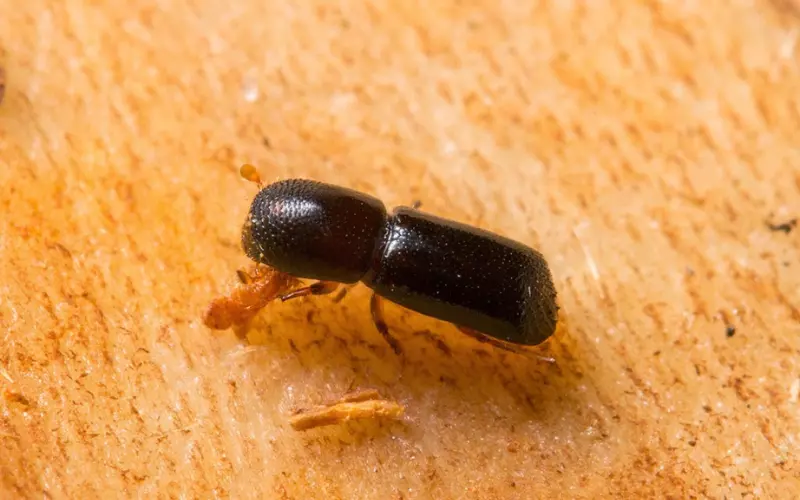
The Ambrosia Beetle is commonly found in many regions around the world. These beetles are most commonly found in North America, Europe, and Asia. They have adapted to habitats such as forests, orchards, and gardens. Ambrosia beetles are attracted to weakened or dying trees and feed on the wood, creating tunnels for their offspring.
However, there are some regions where the Ambrosia Beetle is not found. These include areas with frigid temperatures, such as the Arctic and Antarctic regions. The cold climate in these areas is unsuitable for the beetle’s survival. Additionally, regions with dry desert-like conditions may not provide a suitable environment for them.
The Ambrosia Beetle is found in many regions worldwide, including North America, Europe, and Asia. They are commonly found in forests, orchards, and gardens. However, they are not found in frigid regions such as the Arctic and Antarctic or in dry desert-like areas.
Diet of Ambrosia Beetle

The Ambrosia beetle is a small animal that has a particular diet. These beetles eat a special type of fungus called Ambrosia fungus. The fungus grows inside trees, and the beetles chew on the wood to create small tunnels. Then, they plant the fungus inside the tunnels, which they use as food.
The diet of the Ambrosia beetle is unique. Unlike other beetles that eat leaves or plants, these beetles have a close relationship with the Ambrosia fungus. They help the fungus grow by planting it inside the trees they inhabit. The fungus feeds the beetles by providing them with all the necessary nutrients. In return, the beetles spread the fungus to new trees, allowing it to grow and survive.
The Ambrosia beetle’s diet might seem strange, but it works well for them. They have a special relationship with the Ambrosia fungus that benefits both species. The beetles get all the food they need, and the fungus gets a way to spread and survive. So, even though their diet differs from other beetles, it is ideally suited for survival in the natural world.
Locomotion of Ambrosia Beetle

Ambrosia beetles are tiny creatures that move excitingly. They have particular body parts that help them get around. These beetles have legs that are strong and good at climbing. They can walk very well on different surfaces like trees or wood.
When the ambrosia beetle wants to move fast, it uses its wings. Yes, it can fly! These beetles have tiny, delicate wings they can spread out and fly away with. Flying helps them to travel to new places or find food. Sometimes, they even use their wings to find a mate. Even though ambrosia beetles are small, they have unique abilities that help them move around their environment.
Social and Sexual Behaviour of Ambrosia Beetle
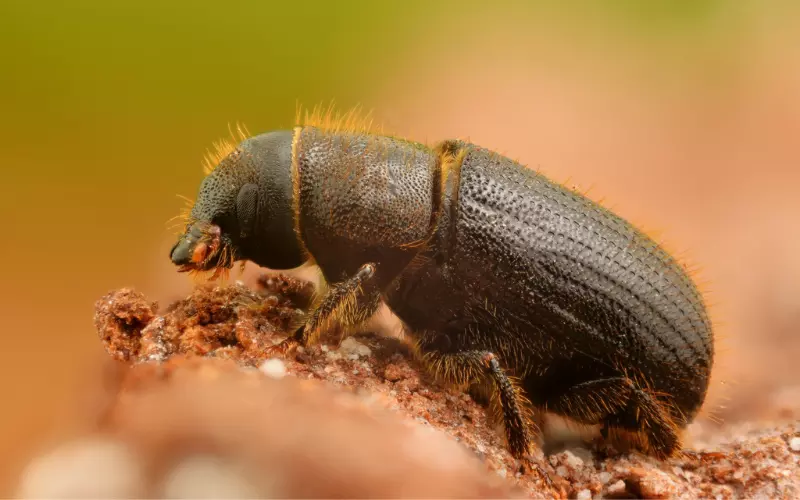
The Ambrosia Beetle is a tiny insect that may not be well-known to everyone. However, this beetle has some interesting social and sexual behaviours. In the beetle world, females have the upper hand when choosing a partner. They release a unique scent to attract males for mating. Once a male arrives, the female evaluates him using her antennae to assess his size and fitness. If she is pleased, they mate, and the female lays her eggs in a tunnel she creates inside a tree.
An intriguing aspect of the Ambrosia Beetle’s social behaviour is their farming-like lifestyle. Once the female has laid her eggs, she cultivates a specific type of fungus for her larvae. The beetle uses the fungus as food for its offspring. The beetle carefully tends to the fungus and protects it from other harmful fungal species. This unique behaviour ensures that the beetle larvae have a nutritious and safe food source to grow and develop.
Regarding sexual behaviour, the Ambrosia Beetle displays a monogamous relationship. This means that once they mate, they stay committed to each other. The female usually remains in the tunnel with the eggs and continues to nurture the fungus, while the male guards the entrance to protect them from predators. This teamwork contributes to the survival of their offspring and highlights the importance of cooperation in the animal kingdom.
The Ambrosia Beetle showcases interesting social and sexual behaviours. Females can choose their mates based on scent and physical characteristics. They also exhibit a farming-like lifestyle by cultivating a particular fungus for their young. Regarding sexual behaviour, these beetles are monogamous and work together to protect their offspring.
Reproduction and Lifecycle of Ambrosia Beetle
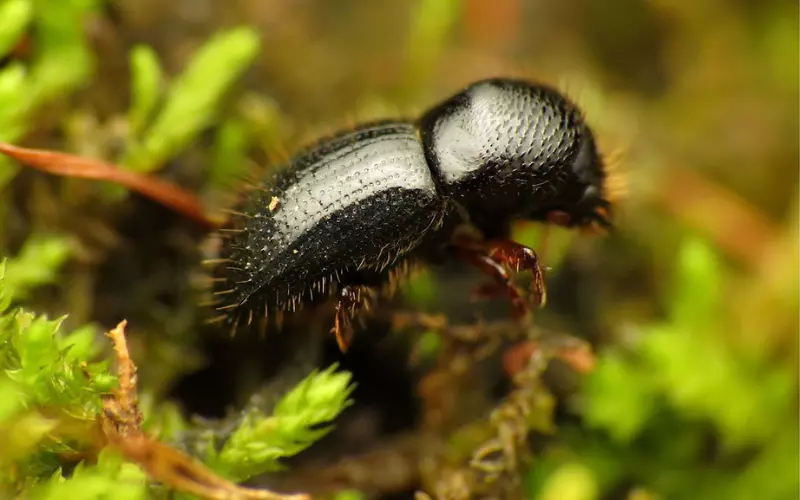
The Ambrosia beetle is a small animal that has a unique life cycle. The reproduction process of these beetles begins when the female lays eggs inside the tunnels it creates underneath the bark of trees. She chews a hole into the tree and creates a small gallery or tunnel for the eggs. The female then releases a fungus called ambrosia that grows and serves food for the larvae when they hatch. This fungus also helps the beetle with digestion.
Once the eggs hatch, the larvae feed on the fungus provided by their mother. As they grow, they consume the fungus until they reach maturity. During this stage, the beetles undergo metamorphosis, transforming from larvae to adult beetles. They have three distinct stages in their life cycle: egg, larvae, and adult. Once the beetles mature into adults, they emerge from the tree and fly away to find a new tree to infest.
The life cycle of an Ambrosia beetle can be pretty short, ranging from a few weeks to a few months. The exact duration depends on various factors, such as environmental conditions and the beetle species. These beetles play a crucial role in forest ecosystems as they assist in the decomposition of dead trees. However, they can also cause damage to healthy trees if their populations become too large. Understanding the Ambrosia beetle’s life cycle and reproduction process helps us understand these fascinating creatures and their environmental impact.
Threats to Ambrosia Beetle
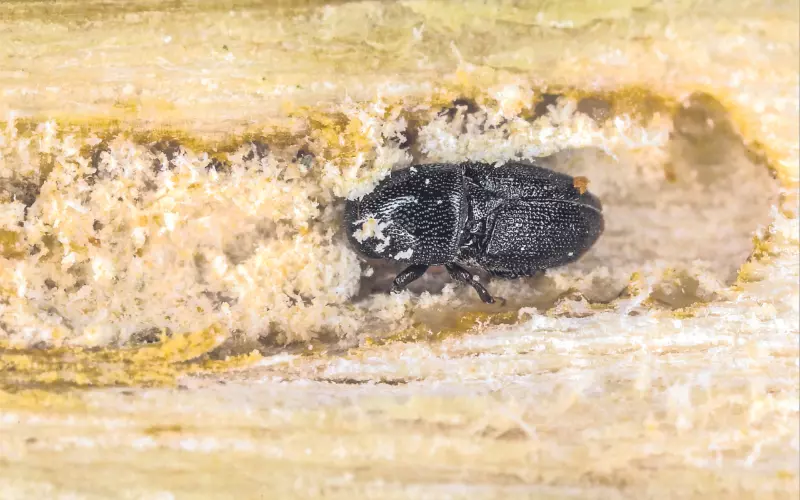
The Ambrosia Beetle animal faces several threats that can harm its survival. One significant threat is deforestation. This means cutting down or destroying the trees where the beetle lives. The Ambrosia Beetle struggles to find food and shelter when their homes are taken away. Without enough food and a safe place to live, their population decreases and may even disappear from specific areas.
Another threat to the Ambrosia Beetle is climate change. This is when the weather patterns become very different from what the beetle is used to. As the Earth gets warmer, some areas may become too hot for the beetle to survive. The changing weather can also disrupt the timing of the beetle’s life cycle, such as when they lay eggs or find food. If they cannot adapt to these changes, their numbers may decline.
Pests and diseases also pose a threat to the Ambrosia Beetle. These are tiny creatures or germs that can harm the beetle’s health. If pests attack the beetle or diseases spread among them, their population can be significantly affected. Sometimes, the pests or diseases may even kill the beetles, resulting in a decline in their numbers.
To protect the Ambrosia Beetle, it is crucial to take action to preserve their natural habitats, reduce deforestation, and combat climate change. By doing so, we can help ensure that these fascinating creatures continue to thrive and play their essential role in our ecosystems.
Population of Ambrosia Beetle

The population of the Ambrosia Beetle is estimated to be quite large, with an assumed figure of millions. These beetles are tiny insects that live in trees and are known for their unique feeding habits. They tunnel into the wood and create galleries where they cultivate fungus, which they later use as a food source. This relationship between the beetle and fungus is essential for their survival.
However, there is no information suggesting that the Ambrosia Beetle is extinct. If this were the case, it would mean that all the beetles of this species have died out and no longer exist. Extinction occurs when a species cannot adapt to environmental changes or faces severe threats that lead to its complete disappearance.
It is essential to protect the habitat of the Ambrosia Beetle and other species, as they play an essential role in maintaining the balance of ecosystems. By conserving their habitats and providing them with the necessary resources, we can ensure these unique creatures continue to thrive.
Conclusion
In the fascinating world of animals, one creature that stands out is the Ambrosia Beetle. This tiny beetle, measuring only a few millimetres, has a rich history and unique facts that make it truly interesting. Found in various habitats worldwide, these beetles play a vital role in the ecosystem.
The Ambrosia Beetle belongs to the Scolytinae family, a group of beetles known for their association with fungi. These beetles have a special relationship with fungi, as they feed on and use them as food sources. This dependence on fungi gives these beetles their name, as they are named after ambrosia, the mythical food of the gods.
These fantastic creatures have been around for millions of years and have evolved into different species with distinct characteristics. They can be found in diverse habitats such as forests, orchards, and urban areas. Despite their small size, these beetles significantly impact the environment as they help decompose dead trees and aid in the natural recycling.
The Ambrosia Beetle is a remarkable creature that contributes to the delicate balance of nature. Its long history, unique facts, and essential role in the ecosystem deserve our attention and appreciation. So, let’s continue to learn about these fascinating animals and their vital role in maintaining a healthy planet.
Frequently Asked Questions about Ambrosia Beetle (FAQ’s)
What is an Ambrosia beetle?
An Ambrosia beetle is an insect that belongs to the weevil family Curculionidae.
What do Ambrosia beetles look like?
Ambrosia beetles are small insects, usually measuring between 1 and 5 millimetres long. They have cylindrical bodies and a hard exoskeleton in various colours, such as black, brown, or reddish.
Are Ambrosia beetles harmful to trees?
Ambrosia beetles can harm trees as they bore into the wood, creating tunnels and galleries where they lay their eggs and cultivate a fungus as their food source.
How do Ambrosia beetles differ from other types of beetles?
Unlike other beetles, Ambrosia beetles feed on fungus rather than wood itself. They also have a unique symbiotic relationship with the fungus, cultivating it in their galleries for nourishment.
What types of trees do Ambrosia beetles typically attack?
Ambrosia beetles can attack many tree species, including hardwood and coniferous trees. They are especially attracted to stressed or weakened trees.
How do Ambrosia beetles reproduce?
Female Ambrosia beetles mate with males; then, they tunnel into a tree, where they lay their eggs. The larvae develop within the galleries and eventually emerge as adults.
Can Ambrosia beetles transmit diseases to trees?
Yes, Ambrosia beetles can transmit various types of fungi, including pathogenic species, which can cause tree diseases.
What are the signs of an Ambrosia beetle infestation in a tree?
Signs of an Ambrosia beetle infestation include small entry holes on the tree trunk, sawdust-like frass around the holes, and wilting or discolouration of the tree’s foliage.
How can I prevent Ambrosia beetles from attacking my trees?
To prevent Ambrosia beetle attacks, it is crucial to maintain the health of your trees by providing proper irrigation, avoiding excessive pruning or injury, and removing any infested or dead wood.
Can Ambrosia beetles be controlled using pesticides?
Pesticides are generally ineffective in controlling Ambrosia beetles once they infest a tree. The best approach is to focus on preventing attacks by maintaining tree health.
Are Ambrosia beetles a threat to crops?
Yes, Ambrosia beetles can threaten crops, especially fruit and nut trees. They can cause damage and reduce crop yield if left unchecked.
Can Ambrosia beetles be found worldwide?
Yes, Ambrosia beetles have a wide distribution and can be found in various parts of the world, including North and South America, Europe, Asia, and Australia.
How long do Ambrosia beetles generally live?
The lifespan of Ambrosia beetles varies between species, but most adults live for several weeks or months.
Can Ambrosia beetle fly?
Ambrosia beetles have wings and can fly, although they are not strong flyers and often rely on wind currents to disperse to new trees.
Are there any natural predators of Ambrosia beetles?
Yes, Ambrosia beetles’ natural predators, such as parasitic wasps and predatory insects, help control their populations in ecosystems.

Hi there, I’m Emily Buono, and I’m thrilled to introduce myself! Currently, I’m part of two fantastic places: I work as a VisEx at the New England Aquarium and as an RAS at MGH CCM.
I completed my education at the Mass General Research Institute and Stonehill College, which is located in Valatie Colony, New York, in the United States.
Now, here’s the exciting part: I absolutely adore animals! They captivate me, and I’m always eager to learn more about them. In fact, I write articles all about these incredible creatures.
In the past, I’ve worn many hats, such as being a biologist at the Maria Mitchell Association, a cashier, a floor organizer, and a visitor experience and research animal specialist.
My passion lies in exploring the world of animals and helping others understand them better. So, if you ever have questions about animals, feel free to reach out. I’m here to make animal info easy and fun to grasp!

